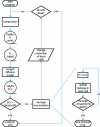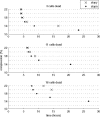Microstructural analysis of deformation-induced hypoxic damage in skeletal muscle
- PMID: 17710456
- PMCID: PMC2798056
- DOI: 10.1007/s10237-007-0097-7
Microstructural analysis of deformation-induced hypoxic damage in skeletal muscle
Abstract
Deep pressure ulcers are caused by sustained mechanical loading and involve skeletal muscle tissue injury. The exact underlying mechanisms are unclear, and the prevalence is high. Our hypothesis is that the aetiology is dominated by cellular deformation (Bouten et al. in Ann Biomed Eng 29:153-163, 2001; Breuls et al. in Ann Biomed Eng 31:1357-1364, 2003; Stekelenburg et al. in J App Physiol 100(6):1946-1954, 2006) and deformation-induced ischaemia. The experimental observation that mechanical compression induced a pattern of interspersed healthy and dead cells in skeletal muscle (Stekelenburg et al. in J App Physiol 100(6):1946-1954, 2006) strongly suggests to take into account the muscle microstructure in studying damage development. The present paper describes a computational model for deformation-induced hypoxic damage in skeletal muscle tissue. Dead cells stop consuming oxygen and are assumed to decrease in stiffness due to loss of structure. The questions addressed are if these two consequences of cell death influence the development of cell injury in the remaining cells. The results show that weakening of dead cells indeed affects the damage accumulation in other cells. Further, the fact that cells stop consuming oxygen after they have died, delays cell death of other cells.
Figures





References
-
- {'text': '', 'ref_index': 1, 'ids': [{'type': 'DOI', 'value': '10.1114/1.1359450', 'is_inner': False, 'url': 'https://doi.org/10.1114/1.1359450'}, {'type': 'PMC', 'value': 'PMC3915047', 'is_inner': False, 'url': 'https://pmc.ncbi.nlm.nih.gov/articles/PMC3915047/'}, {'type': 'PubMed', 'value': '11339327', 'is_inner': True, 'url': 'https://pubmed.ncbi.nlm.nih.gov/11339327/'}]}
- Beard DA, Bassingthwaighte JB (2001) Modeling advection and diffusion of oxygen in complex vascular networks. Ann Biomed Eng 29:298–10 - PMC - PubMed
-
- {'text': '', 'ref_index': 1, 'ids': [{'type': 'PubMed', 'value': '8322911', 'is_inner': True, 'url': 'https://pubmed.ncbi.nlm.nih.gov/8322911/'}]}
- Bentley TB, Meng H, Pittman RN (1993) Temperature dependence of oxygen diffusion and consumption in mammalian striated muscle. Am J Physiol Heart Circu Physiol 264:H1825–H1830 - PubMed
-
- {'text': '', 'ref_index': 1, 'ids': [{'type': 'DOI', 'value': '10.1016/S0967-2109(02)00070-4', 'is_inner': False, 'url': 'https://doi.org/10.1016/s0967-2109(02)00070-4'}, {'type': 'PubMed', 'value': '12453699', 'is_inner': True, 'url': 'https://pubmed.ncbi.nlm.nih.gov/12453699/'}]}
- Blaisdell FW (2002) The pathophysiology of skeletal muscle ischemia and the reperfusion symdrome: a review. Cardiovasc Surg 10(6):620–30 - PubMed
-
- {'text': '', 'ref_index': 1, 'ids': [{'type': 'PubMed', 'value': '7784116', 'is_inner': True, 'url': 'https://pubmed.ncbi.nlm.nih.gov/7784116/'}]}
- Bogie KM, Nuseibeh I, Bader DL (1995) Early progressive changes in tissue viability in the seated spinal cord injured subject. Paraplegia 33:141–47 - PubMed
-
- {'text': '', 'ref_index': 1, 'ids': [{'type': 'DOI', 'value': '10.1016/S0021-9290(01)00083-5', 'is_inner': False, 'url': 'https://doi.org/10.1016/s0021-9290(01)00083-5'}, {'type': 'PubMed', 'value': '11522318', 'is_inner': True, 'url': 'https://pubmed.ncbi.nlm.nih.gov/11522318/'}]}
- Bosboom EMH, Hesselink MKC, Oomens CWJ, Bouten CVC, Drost MR, Baaijens FPT (2001) Passive transverse mechanical properties of skeletal muscle under in vivo compression. J Biomech 34:1365–368 - PubMed
MeSH terms
Substances
LinkOut - more resources
Full Text Sources
Other Literature Sources
Medical
